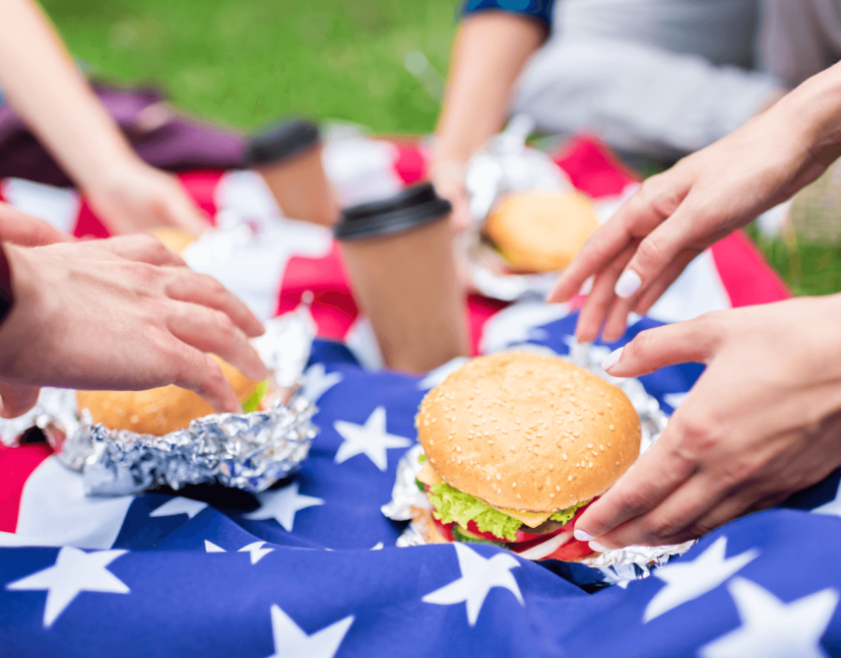
Grill Safety Tips for a Safe Fourth of July
As the 4th of July approaches, the excitement of commemorating Independence Day with a festive cookout is palpable. However, amidst the celebrations, the safety of friends, family, and community takes precedence. Ensuring a secure environment for everyone involved becomes paramount, as the day’s festivities often involve activities that pose potential hazards, such as grilling, fireworks, and large gatherings. By focusing on 4th of July safety tips, individuals can foster a celebratory atmosphere while mitigating risks, making the holiday enjoyable and safe for everyone.
This article serves as a comprehensive guide to hosting a safe 4th of July cookout, covering essential aspects from grilling safety guidelines, through proper food preparation and storage, to managing fireworks and outdoor activities safely. Additionally, it offers insights into general safety tips for large gatherings, ensuring a well-rounded approach to minimizing risks during Independence Day celebrations. By adhering to the advice provided, hosts can confidently enjoy the holiday, knowing they have taken proactive steps to ensure the safety and well-being of all attendees.
Grilling Safety Guidelines
Ensuring Your Grill is in a Safe Location
- Outdoor Placement: Always position grills outdoors in a well-ventilated area away from the home, deck railings, and overhanging branches to minimize fire risks.
- Distance from Combustibles: Maintain a minimum distance of 10 feet from any structures or combustible materials to prevent fires from spreading.
- Stable Surface: Set up grills on stable, level surfaces like concrete to avoid tipping over, which can lead to fires.
Checking for Gas Leaks and Ensuring Proper Grill Maintenance
- Regular Inspections: Before each use, especially after long storage periods, inspect your grill for signs of wear and tear, including gas leaks and hose deterioration.
- Leak Testing: Mix a 50/50 solution of water and dish soap and apply it to the gas valve, hose, and regulator. Bubbles indicate a leak which requires immediate attention.
- Maintenance Routine: Clean grills regularly to remove grease buildup that can ignite. Check and replace worn-out parts like hoses and connectors to ensure they are in good condition.
Keeping Flammable Materials Away from the Grill Area
- Clear Zone: Keep flammable items such as paper plates, napkins, and cooking oils at least 3 feet away from the grill.
- Proper Storage: Store extra propane tanks and lighter fluids away from the grill and heat sources to avoid accidental ignition.
- Clothing Safety: Avoid wearing loose clothing and ensure all apron strings or similar items are secured away from the grill to prevent them from catching fire.
Food Preparation and Storage
Washing Hands and Surfaces Regularly
Maintaining cleanliness is crucial during food preparation to prevent bacteria spread. Always wash hands with soap and water for at least 20 seconds before and after handling food. Surfaces like cutting boards and countertops should be cleaned with hot, soapy water after each use. Using paper towels or clean cloths for wiping down surfaces can further minimize bacterial contamination.
Separating Different Types of Food to Avoid Cross-Contamination
Keep raw meat, poultry, and seafood separate from ready-to-eat foods to avoid cross-contamination. Use separate cutting boards and utensils for raw and cooked foods. After handling raw meats, it’s essential to clean all related utensils and surfaces thoroughly with hot, soapy water to prevent bacteria from spreading to other foods.
Following the ‘2-Hour Rule’ for Leaving Food Out at Room Temperature
Perishable foods should not be left out at room temperature for more than two hours. In temperatures above 90°F, this time reduces to just one hour. Bacteria grow rapidly between 40°F and 140°F, doubling in number in as little as 20 minutes. Adhering to this rule helps prevent foodborne illnesses.
Storing Foods at the Correct Temperature to Prevent Spoilage
Proper storage of food is vital for maintaining safety and freshness. Refrigerate or freeze perishables, prepared foods, and leftovers within two hours of purchase or preparation. Ensure that the refrigerator is set to 40°F or below and the freezer at 0°F. Regularly monitoring these temperatures can prevent potential food spoilage and reduce the risk of foodborne illnesses.
Cooking to the Correct Temperature
Using a Food Thermometer for Meat and Poultry
To ensure safety and prevent foodborne illnesses, using a food thermometer is crucial when cooking meat, poultry, and egg products. This method is the only reliable way to verify that the food has reached a safe minimum internal temperature. It is important to note that visual indicators such as color changes are not reliable for assessing doneness. For instance, ground beef might turn brown before reaching a temperature that kills harmful pathogens. Always insert the thermometer at least two inches into the center of the largest muscle or thickest portion of the meat, ensuring it does not touch bone, fat, or the pan for an accurate reading.
Understanding the Safe Internal Temperatures for Different Types of Food
| Food Type | Internal Temperature (°F/°C) | Notes |
| Beef, Pork, Veal & Lamb (steaks, chops, roasts) | 145°F (62.8°C) | Rest for 3 minutes |
| Ground Meats | 160°F (71.1°C) | – |
| All Poultry | 165°F (73.9°C) | – |
| Fish & Shellfish | 145°F (62.8°C) | Or until flesh is opaque |
| Eggs | 160°F (71.1°C) | – |
| Leftovers & Casseroles | 165°F (73.9°C) | – |
Following these guidelines helps ensure that meats are cooked to temperatures that are safe for consumption. Additionally, it’s beneficial to allow meats like beef, pork, veal, and lamb to rest for at least three minutes after reaching the desired internal temperature to allow juices to redistribute and finish cooking internally. This resting period is crucial for achieving both optimal safety and quality in cooked meats.
Fireworks and Outdoor Activities Safety
Staying Clear of Illegal Fireworks and Considering Public Displays Instead
Fireworks can transform a festive occasion into a memorable spectacle. However, the allure of creating a personal display can lead to the use of illegal fireworks, which pose significant risks including severe injuries and fires. Annually, thousands of injuries that require emergency medical attention occur due to the misuse of fireworks. To ensure safety, it is recommended to enjoy fireworks through public displays conducted by professionals. These events are conducted under controlled conditions and adhere to stringent safety regulations, significantly reducing the likelihood of accidents.
Securing the Area Around Fireworks for Safety
When using fireworks, it is crucial to secure the immediate area. Fireworks should be set off in a clear, open space away from buildings, vehicles, and flammable materials. This precaution helps in preventing unintended fires and injuries. Always maintain a safe distance after lighting fireworks and ensure that all spectators are at a safe viewing distance. Additionally, keep a bucket of water or a garden hose nearby to manage any accidental fires or to soak fireworks that fail to ignite.
Monitoring Weather Conditions, Especially Wind, When Setting Off Fireworks
Weather conditions can greatly influence the safety of fireworks displays. High winds can alter the trajectory of fireworks, potentially directing them towards spectators or flammable materials. Before initiating a fireworks display, check the weather forecast and avoid using fireworks in windy conditions. It is also advisable to monitor changes in weather throughout the event and be prepared to cease the fireworks display if conditions become unfavorable. By taking these precautions, you can help ensure a safe environment for everyone involved.
General Safety Tips for Large Gatherings
Keeping an Eye on Children and Pets in Crowded Environments
- Active Supervision: Always ensure active supervision when children and pets are present at large gatherings. This means continuously scanning the area for potential hazards and staying within close proximity to respond quickly if needed.
- Safe Zones: Designate specific, safe areas for children to play and pets to rest, away from the main crowd to prevent them from wandering off.
- Identifiable Gear: Provide children and pets with identifiable gear such as wristbands or collars with contact information, which can be invaluable in case they get lost.
Being Aware of Your Guests’ Dietary Restrictions and Allergies
- Advance Communication: Discuss menu options with guests ahead of time to identify any dietary restrictions or allergies. This proactive approach allows for necessary adjustments to the menu to accommodate all guests.
- Clear Labeling: Use clear, visible labels for all dishes served, listing key ingredients and highlighting common allergens. This helps guests make safe food choices without having to ask about every dish.
- Separate Utensils and Dishes: To prevent cross-contamination, always use separate utensils and serving dishes for allergen-free and regular items.
Staying Hydrated and Mindful of Sun Exposure During Outdoor Activities
- Hydration Stations: Set up multiple hydration stations with water and other hydrating beverages like coconut water or fruit-infused drinks. Ensure these are easily accessible throughout the venue.
- Shade and Cooling Areas: Provide ample shaded or air-conditioned areas where guests can rest and cool down. Consider setting up mist fans in particularly hot areas.
- Protective Gear: Encourage guests to wear hats, sunglasses, and apply sunscreen to protect against UV rays. Offer sunscreen at the venue for those who may not have brought their own.
Conclusion
Through this article, we’ve navigated the multi-faceted realm of ensuring a joyous and secure 4th of July celebration. By embracing prudent grilling practices, food preparation, and handling protocols, along with a keen awareness of fireworks safety and the nuances of hosting large gatherings, hosts can significantly elevate the safety level of their events. Such meticulous preparations not only uphold the spirit of Independence Day but also protect the well-being of every participant, allowing them to indulge in the festivities with peace of mind.
As we conclude, embrace these tips to orchestrate a celebration that’s memorable for all the right reasons. The collective effort towards safety underscores the care and respect for our loved ones and the community at large. And as you march forward to celebrate this 4th of July, Safety Northeast Insurance wishes you a splendid and safe holiday. This proactive approach extends beyond mere celebration; it is a powerful expression of our commitment to fostering safe and inclusive environments for everyone to enjoy.

 Previous Post
Previous Post Next Post
Next Post